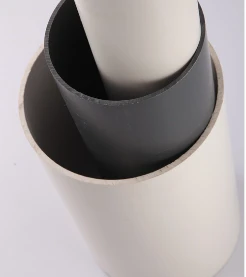Dùbh . 01, 2024 00:43 Back to list
plumbing pipes and fittings
Understanding Plumbing Pipes and Fittings
Plumbing is an essential aspect of modern infrastructure, governing how water and waste travel in and out of our homes and buildings. A critical component of any plumbing system is the pipes and fittings, which play vital roles in the overall functionality and efficiency of water delivery and waste removal systems. This article will explore the different types of plumbing pipes and fittings, their purposes, and important considerations for installation and maintenance.
Types of Plumbing Pipes
1. PVC (Polyvinyl Chloride) Pipes These white, rigid plastic pipes are widely used in residential and commercial plumbing. PVC pipes are lightweight, easy to install, and corrosion-resistant, making them suitable for both cold and warm water applications. They are most commonly used for drain, waste, and vent systems due to their smooth interior, which reduces friction and clogs.
2. CPVC (Chlorinated Polyvinyl Chloride) Pipes Similar to PVC, CPVC is rated for higher temperatures and can be used for both hot and cold water. It's yellowish in color and can be installed using solvent cement, which chemically bonds the pipes. It is commonly used in residential plumbing for hot water lines and is often preferred where higher temperatures are a concern.
3. PEX (Cross-Linked Polyethylene) Pipes PEX is a flexible plastic piping that has become increasingly popular in modern plumbing due to its versatility and ease of installation. It can bend around corners, eliminating the need for fittings in many cases. PEX is resistant to scale, chlorine, and corrosion, making it ideal for both hot and cold water systems.
4. Copper Pipes Copper has been a trusted material for decades due to its durability and reliability. It is often used in household plumbing for water supply lines. Copper pipes are resistant to corrosion, can withstand high temperatures, and offer a longer lifespan compared to other materials. However, they can be more expensive and require skilled labor for installations.
5. Galvanized Steel Pipes These pipes were commonly used in homes prior to the 1960s but have fallen out of favor due to their susceptibility to corrosion over time. They are coated with zinc to prevent rusting, but their interior can become clogged with mineral deposits. Replacing galvanized pipes is often recommended if they are still in use.
Types of Plumbing Fittings
plumbing pipes and fittings

Fittings are the components that connect sections of pipe together, allowing for changes in direction, flow control, and branching in plumbing systems. Understanding the different types of fittings is crucial for achieving a well-designed plumbing layout.
1. Elbows These fittings allow for directional changes in piping, commonly available in 90-degree and 45-degree angles. Elbows are essential for navigating obstacles in plumbing systems.
2. Tees A tee fitting has one inlet and two outlets, allowing water to flow in multiple directions. They are vital for branching off supply lines to different fixtures in a home.
3. Couplings These are used to connect two sections of pipe together, ensuring a continuous flow. Couplings can be threaded or solvent-welded, depending on the type of pipe material.
4. Reducers These fittings allow for the connection of pipes of different diameters. They help maintain flow rates and pressures when transitioning from larger to smaller pipes.
5. Valves Valves control the flow of water and are installed at various points in a plumbing system. Common types include ball valves, gate valves, and check valves, each serving specific operational needs.
Considerations for Installation and Maintenance
When installing plumbing pipes and fittings, several factors should be considered to ensure a reliable and efficient system. This includes understanding local plumbing codes, selecting the appropriate materials for specific applications, and ensuring that all connections are secure to prevent leaks. Regular maintenance is also essential to prolong the lifespan of plumbing systems. Homeowners should routinely inspect for leaks, clear any clogs, and consider periodic professional inspections to catch potential issues early.
In conclusion, plumbing pipes and fittings are crucial for effective water distribution and waste management in our homes. By understanding the various types of pipes and fittings available, along with their respective benefits and applications, homeowners can make informed decisions that enhance their plumbing systems' efficiency and longevity. Proper installation and maintenance practices are equally important to ensure that these systems function reliably for years to come.
-
High-Quality HDPE Sheet | Durable Plastic Panels
NewsAug.06,2025
-
High-Precision PVC Rigid Sheets for Vacuum Forming | AI-Optimized
NewsAug.05,2025
-
Durable PVC-M Water Supply Pipes | 60-Year Life
NewsAug.04,2025
-
Premium HDPE Water Supply Pipes: Durable & Leak-Proof
NewsAug.03,2025
-
Premium PVC-M Water Supply Pipe - Durable & Efficient
NewsAug.02,2025
-
HDPE Drainage & Irrigation Pipe - Durable, Efficient Solutions
NewsAug.01,2025

